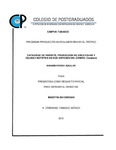| dc.description.abstract | No existen estudios sobre el efecto de diferentes condiciones de manejo en la producción de follaje y composición química de especies del género Crotalaria en México, particularmente del Chipilín (Crotalaria longirostrata Hook. & Arn.), quelite nativo de Mesoamérica, del que se consumen sus hojas y brotes tiernos en el sur-sureste de México, o de especies exóticas presentes en el estado de Tabasco como es la arvense Ala de pico (Crotalaria retusa L.) usada en la medicina tradicional en África, y Asia de donde es originaria. Por ello, el objetivo fue evaluar la capacidad de rebrote y la calidad nutricional de la biomasa producida de Chipilín y Ala de pico en respuesta a cortes sucesivos del follaje y fertilización. A partir de tres cortes mensuales aplicados al follaje de ambas especies y dosis de fertilización (0-0-0, 100-0-0, 0-60-0 kg ha-1 de N, P2O5 y K2O) se determinó el número, longitud y peso de tallos secundarios, biomasa, área foliar, índice diferencial de vegetación normalizado (NDVI), concentración de pigmentos fotosintéticos, proteína, grasa, cenizas, azúcares solubles, fibra dietética total y polifenoles totales. La aleatorización de los tratamientos se realizó mediante un diseño completamente al azar con seis repeticiones, y se analizó con el modelo de medidas repetidas. El Chipilín mostró una mayor capacidad de rebrote que el ala pico, ya que la cantidad y la biomasa de rebrotes por planta aumentaron debido a los sucesivos cortes de follaje. La fertilización no tuvo efecto en el crecimiento y biomasa aérea de ambas especies, pero disminuyó la biomasa de raíz en Chipilín. La fertilización afectó negativamente la nodulación en ambas especies, principalmente la fertilización nitrogenada. El efecto de la fertilización fue no significativo para el contenido de grasa, cenizas, azúcares reductores y polifenoles totales. La fertilización fosfatada disminuyó el contenido de fibra dietética solo en hojas de Chipilín. Entre especies, el Chipilín presentó contenidos más altos de proteína, de cenizas y de fibra dietética que Ala de pico. Este es el primer estudio en México sobre el manejo del follaje de Chipilín, el cual muestra que este mejora el rendimiento y calidad de la biomasa foliar. _______________ REGROWTH CAPACITY, LEAF AREA PRODUCTION AND NUTRITIONAL QUALITY OF TWO SPECIES OF THE CROTALARIA GENRE. ABSTRACT: There are no studies on the effect of different management conditions on the production of foliage and chemical composition of species of the Crotalaria genus in Mexico, particularly of Chipilín (Crotalaria longirostrata Hook. & Arn.), quelite native to Mesoamerica, whose tender leaves and buds are eaten in the south-southeast of Mexico, or of exotic species present in the state of Tabasco such as Ala de pico weed (Crotalaria retusa L.) used in traditional medicine in Africa, and Asia from where it is native. Therefore, the objective was to evaluate the regrowth capacity and nutritional quality of the biomass produced from Chipilín and Ala de pico in response to successive cuts of foliage and fertilization. From three monthly cuts applied to the foliage of both species and fertilization dose (0-0-0, 100-0-0, 0-60-0 kg ha-1 of N, P2O5 and K2O) the number, length and weight of secondary stems, biomass, leaf area, standardized differential vegetation index (NDVI), concentration of photosynthetic pigments, protein, fat, ash, soluble sugars, total dietary fiber and total polyphenols were determined. The randomization of the treatments was by a completely randomized design with six repetitions, and they were analyzed with the repeated measures model. The Chipilín showed a greater regrowth capacity than Ala de pico, as the shoots number and regrowth biomass per plant increased due to the successive cuts to the foliage. Fertilization had no effect on growth and aerial biomass of both species but decreased root biomass in Chipilín. Fertilization negatively affected nodulation in both species, mainly nitrogen fertilization. The effect of fertilization was not significant for fat content, ashes, reducing sugars and total polyphenols. Phosphate fertilization decreased the dietary fiber content only in Chipilín leaves. Among species, Chipilín had higher protein, ash and dietary fiber contents than Ala de pcio. This is the first study in Mexico on Chipilin foliage management, which improves the yield and quality of leaf biomass. | es_MX |


